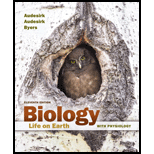
Biology: Life on Earth with Physiology (11th Edition)
11th Edition
ISBN: 9780133923001
Author: Gerald Audesirk, Teresa Audesirk, Bruce E. Byers
Publisher: PEARSON
expand_more
expand_more
format_list_bulleted
Question
Chapter 37, Problem 2FIB
Summary Introduction
Introduction:
The body’s mechanisms that protect against the infections are innate defense and adaptive defense. Innate defense is also known as a nonspecific defense which provides response regardless of exposure numbers and pathogen type. It includes mechanical barrier, natural killer cell, species resistance, chemical barriers, fever, inflammation, and phagocytosis.
Expert Solution & Answer
Want to see the full answer?
Check out a sample textbook solution
Students have asked these similar questions
↑
LED
Tt O
Tt e 0 ✓
B
>
FLORES DIology Second Semester Review
7. Chi Square Analysis: wild dumpy male x ebony wild female
F1:
All wild wild
F2:
142 wild wild males
52 wild ebony males
46 dumpy wild males
17 dumpy ebony males
151 wild wild females
47 wild ebony females
51 dumpy wild females
8 dumpy ebony females
What pattern of inheritance is observed for body color?
Autosomal recessive
Autosomal dominant
Sex-linked recessive
Sex-linked dominant
What are the genotypes of the parents in the P generation?
a.
XBYdd x XbXbDD
b. Bbdd x bbDd
c. BBdd x bbDD
d. BBX Y x bbXDY
How many flies in the F2 generation would you expect to express the dumpy wild phenotype?
a.
289.125
b. 97
c. 96.375
d. 293
4. This question focuses on entrainment.
a. What is entrainment?
b. What environmental cues are involved in entrainment, and which one is most influential?
c. Why is entrainment necessary?
d. Assuming that a flash of darkness is an effective zeitgeber, what impact on circadian
rhythms would you expect to result from an event such as the 2024 solar eclipse (assume
it was viewed from Carbondale IL, where totality occurred at about 2 pm)? Explain your
reasoning. You may wish to consult this phase response diagram.
Phase Shift (Hours)
Delay Zone
Advance Zone
Dawn
Mid-day
Dusk
Night
Dawn
Time of Light Stimulus
e. Finally, give a real-world example of how knowledge of circadian rhythms and
entrainment has implications for human health and wellbeing or conservation biology.
This example could be from your reading or from things discussed in class.
Generate one question that requires a Punnet Squre to solve the question. Then show how you calculate the possibilities of genotype and phenotype
Chapter 37 Solutions
Biology: Life on Earth with Physiology (11th Edition)
Ch. 37.1 - compare and contrast the terms microbe and...Ch. 37.1 - Prob. 2CYLCh. 37.2 - If phagocytes kill most species of bacteria that...Ch. 37.2 - describe the external barriers to Infection,...Ch. 37.2 - Prob. 1TCCh. 37.2 - Prob. 2CYLCh. 37.3 - Prob. 1CYLCh. 37.3 - Prob. 2CYLCh. 37.4 - Prob. 1CYLCh. 37.4 - Prob. 2CYL
Ch. 37.4 - Prob. 3CYLCh. 37.5 - Prob. 1CYLCh. 37.5 - Prob. 2CYLCh. 37.6 - Prob. 1CYLCh. 37.6 - Prob. 2CYLCh. 37.7 - explain how antibiotics, antiviral drugs, and...Ch. 37.7 - Prob. 1ETCh. 37.7 - Prob. 1HYEWCh. 37.7 - Prob. 1TCCh. 37.7 - Prob. 2CYLCh. 37.8 - Prob. 1CYLCh. 37.8 - What might be the evolutionary advantage of...Ch. 37.9 - Prob. 1CSRCh. 37.9 - Prob. 1CTCh. 37.9 - Prob. 1CYLCh. 37.9 - describe current medical treatments against...Ch. 37 - Why is it essential that antibodies and T-cell...Ch. 37 - External defenses against microbial invasion...Ch. 37 - Prob. 1MCCh. 37 - Prob. 1RQCh. 37 - Prob. 2ACCh. 37 - Prob. 2FIBCh. 37 - Prob. 2MCCh. 37 - Prob. 2RQCh. 37 - Prob. 3FIBCh. 37 - Molecules that label your cells as self are a....Ch. 37 - Describe humoral immunity and cell-mediated...Ch. 37 - Prob. 4FIBCh. 37 - Prob. 4MCCh. 37 - Prob. 4RQCh. 37 - Prob. 5FIBCh. 37 - The immune system usually does not attack your...Ch. 37 - Prob. 5RQCh. 37 - Prob. 6FIBCh. 37 - Prob. 6RQCh. 37 - What are memory cells? How do they contribute to...Ch. 37 - Prob. 8RQCh. 37 - Prob. 9RQCh. 37 - Prob. 10RQCh. 37 - Prob. 11RQ
Knowledge Booster
Similar questions
- Briefly state the physical meaning of the electrocapillary equation (Lippman equation).arrow_forwardExplain in a small summary how: What genetic information can be obtained from a Punnet square? What genetic information cannot be determined from a Punnet square? Why might a Punnet Square be beneficial to understanding genetics/inheritance?arrow_forwardIn a small summary write down:arrow_forward
- Not part of a graded assignment, from a past midtermarrow_forwardNoggin mutation: The mouse, one of the phenotypic consequences of Noggin mutationis mispatterning of the spinal cord, in the posterior region of the mouse embryo, suchthat in the hindlimb region the more ventral fates are lost, and the dorsal Pax3 domain isexpanded. (this experiment is not in the lectures).a. Hypothesis for why: What would be your hypothesis for why the ventral fatesare lost and dorsal fates expanded? Include in your answer the words notochord,BMP, SHH and either (or both of) surface ectoderm or lateral plate mesodermarrow_forwardNot part of a graded assignment, from a past midtermarrow_forward
arrow_back_ios
SEE MORE QUESTIONS
arrow_forward_ios
Recommended textbooks for you
- Essentials of Pharmacology for Health ProfessionsNursingISBN:9781305441620Author:WOODROWPublisher:Cengage
 Human Heredity: Principles and Issues (MindTap Co...BiologyISBN:9781305251052Author:Michael CummingsPublisher:Cengage Learning
Human Heredity: Principles and Issues (MindTap Co...BiologyISBN:9781305251052Author:Michael CummingsPublisher:Cengage Learning Human Physiology: From Cells to Systems (MindTap ...BiologyISBN:9781285866932Author:Lauralee SherwoodPublisher:Cengage Learning
Human Physiology: From Cells to Systems (MindTap ...BiologyISBN:9781285866932Author:Lauralee SherwoodPublisher:Cengage Learning


Essentials of Pharmacology for Health Professions
Nursing
ISBN:9781305441620
Author:WOODROW
Publisher:Cengage


Human Heredity: Principles and Issues (MindTap Co...
Biology
ISBN:9781305251052
Author:Michael Cummings
Publisher:Cengage Learning

Human Physiology: From Cells to Systems (MindTap ...
Biology
ISBN:9781285866932
Author:Lauralee Sherwood
Publisher:Cengage Learning
